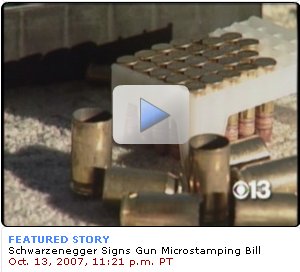Pistol Micro-Stamping Becomes Law in California
On October 13th, California Gov. Swarzenegger signed a bill requiring that all semi-automatic pistols sold in California have internal parts that “micro-stamp” shell casings with identifying codes. Under the terms of the new law, semi-auto pistols sold after 1/1/2010 would have to stamp shell casings in at least two places. Typically, this means the firing pin and the ejector will be embossed with characters that are transferred to the primer and case rim on firing.
The micro-stamping law is a very bad piece of legislation for a variety of reasons. Hopefully this misguided concept will not spread to other states. Key problems with the micro-stamping technology include:
1. The raised markers on the end of the firing pin and ejector can easily be removed or altered with a simple file, or even sandpaper.
 2. Independent tests show that current micro-stamping technology does NOT produce reliable results: “George G. Krivosta, of the Suffolk County Crime Laboratory in New York, did some research on the firearm microstamping technology offered by NanoTag [the sole approved micro-stamping system in California]. In his research, using tagged firing pins in a .22 Long Rifle rifle and a .45 ACP pistol, he found that very few firing pin strikes actually resulted in legible marks, as it was very common for the firing pin to bounce on impact and strike the case more than once, with successive strikes landing slightly off of the original position and obscuring the original strike impression. Out of the first 100 rounds fired using an 8-character alphanumeric code, 54 provided satisfactory markings, while the remaining 46 had at least one illegible character. Smaller print, encoding the make, model, and serial number for a total of 45 characters, resulted in far less clear markings which were difficult to decipher even under ideal circumstances.” Source: Wikipedia, summarizing AFTE Journal Article.
2. Independent tests show that current micro-stamping technology does NOT produce reliable results: “George G. Krivosta, of the Suffolk County Crime Laboratory in New York, did some research on the firearm microstamping technology offered by NanoTag [the sole approved micro-stamping system in California]. In his research, using tagged firing pins in a .22 Long Rifle rifle and a .45 ACP pistol, he found that very few firing pin strikes actually resulted in legible marks, as it was very common for the firing pin to bounce on impact and strike the case more than once, with successive strikes landing slightly off of the original position and obscuring the original strike impression. Out of the first 100 rounds fired using an 8-character alphanumeric code, 54 provided satisfactory markings, while the remaining 46 had at least one illegible character. Smaller print, encoding the make, model, and serial number for a total of 45 characters, resulted in far less clear markings which were difficult to decipher even under ideal circumstances.” Source: Wikipedia, summarizing AFTE Journal Article.
NOTE: This article contains numerous photos illustrating “failed” micro-stamp primer markings. The article also shows how the firing pin embossing wears out quickly. You should download the article and view for yourself.
3. Would-be law-breakers can collect spent brass from shooting ranges, and “throw down” micro-stamped brass at crime scenes, creating the possibility that innocent gun-owners will be implicated in crimes. Worse yet, the presence of micro-stamped brass belonging to someone else creates “reasonable doubt”, so the real criminal can’t be convicted.
4. The law does not apply to revolvers (so far at least). Word will quickly get out “on the street” on how to defeat the law by using revolvers or altered firing pins.
5. The law may make it difficult, if not impossible (from a practical standpoint), to replace broken or damaged firing pins, ejectors, and extractors. All such components will have to be strictly regulated.
Click the image below for a recent news report on the new California law. As one might expect, the news report did not disclose the technological shortcomings of the micro-stamping process, nor does the report explain how this could backfire, resulting in law-abiding citizens being arrested if their spent brass is found at crime scenes:



















